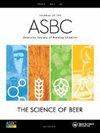Recognition of Japanese Sake Quality Using Machine Learning Based Analysis of Physicochemical Properties
IF 1.8
4区 农林科学
Q4 BIOTECHNOLOGY & APPLIED MICROBIOLOGY
Journal of the American Society of Brewing Chemists
Pub Date : 2021-07-22
DOI:10.1080/03610470.2021.1939973
引用次数: 2
Abstract
Abstract Rapid recognition of Japanese sake quality (flavor and types of sake) is an important factor affecting consumers’ preference, quality control, as well as fraud avoidance in sake labelling. This study attempted to find a prediction model that could precisely predict sake flavor grades (Q1, Q2, and Q3) and to discover a classification model that could precisely differentiate the types of sake, specifically between Junmaishu and Honjozoshu. Twelve physicochemical properties of 407 sake were analyzed and sensory evaluation of 260 sake from 510 professional evaluators were further collected. The physicochemical properties, data, and sensory evaluation of 260 sake were utilized to predict sake flavor grades, while physicochemical properties data of 407 sake were used to classify the type of sake. Artificial neural network (ANN—including multilayer perceptron classifier—MLP classifier), random forest, support vector machine, and k-nearest neighbor were implemented to achieve the objective. ANN gained an accuracy of 91.14% and precision of Q1 87.5%, Q2 93.55% and Q3 77.78% for sake flavor grades prediction. As for types of sake classification, MLP classifier gained 100% accuracy as well as 100% precision of Junmaishu and Honjozoshu. In general, the physiochemical properties combined with ANN can recognize the quality of Japanese sake.基于物理化学性质分析的机器学习识别日本清酒质量
摘要快速识别日本清酒的质量(清酒的风味和类型)是影响消费者偏好、质量控制以及避免清酒标签欺诈的重要因素。本研究试图找到一个可以精确预测清酒风味等级(Q1、Q2和Q3)的预测模型,并发现一个可以准确区分清酒类型的分类模型,特别是在君麦酒和本酒之间。对407份清酒的12个理化性质进行了分析,并进一步收集了510名专业评价人员对260份清酒进行了感官评价。利用260份清酒的理化性质、数据和感官评价来预测清酒的风味等级,而407份清酒则利用理化性质数据来分类清酒的类型。实现了人工神经网络(ANN——包括多层感知器分类器——MLP分类器)、随机森林、支持向量机和k近邻。人工神经网络预测清酒风味等级的准确率为91.14%,精度分别为Q1 87.5%、Q2 93.55%和Q3 77.78%。对于清酒的分类类型,MLP分类器获得了100%的准确率,同时也获得了君麦树和Honjozoshu的100%的准确度。一般来说,理化性质与人工神经网络相结合可以识别日本清酒的质量。
本文章由计算机程序翻译,如有差异,请以英文原文为准。
求助全文
约1分钟内获得全文
求助全文
来源期刊

Journal of the American Society of Brewing Chemists
工程技术-生物工程与应用微生物
CiteScore
4.00
自引率
20.00%
发文量
41
审稿时长
3 months
期刊介绍:
The Journal of the American Society of Brewing Chemists publishes scientific papers, review articles, and technical reports pertaining to the chemistry, microbiology, and technology of brewing and distilling, as well as the analytical techniques used in the malting, brewing, and distilling industries.
 求助内容:
求助内容: 应助结果提醒方式:
应助结果提醒方式:


